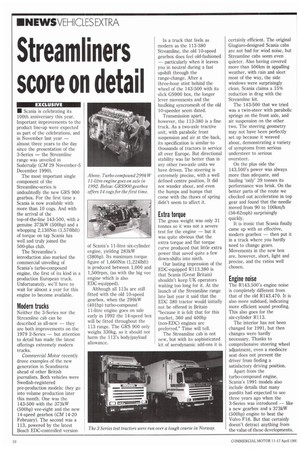Streamliners score on detail
Page 12

If you've noticed an error in this article please click here to report it so we can fix it.
• Scania is celebrating its 100th anniversary this year. Important improvements to the product line-up were expected as part of the celebrations, and in November last year — almost three years to the day since the presentation of the 3-Series — the Streamline range was unveiled in Sodertalje (CM 29 November-5 December 1990).
The most important single component of the Streamline-series is undoubtedly the new GRS 900 gearbox. For the first time a Scania is now available with more than 10 cogs. And with the arrival of the top-of-the-line 143-500, with a genuine 373kW (500hp) and a whopping 2,130Nm (1,5701bft) of torque on tap Scania has well and truly joined the 500-plus club.
The Streamline's introduction also marked the commercial unveiling of Scania's turbo-compound engine, the first of its kind in a production European truck. Unfortunately, we'll have to wait for almost a year for this engine to become available.
Modern trucks
Neither the 3-Series nor the Streamline cab can be described as all-new — they are both improvements on the 1979 2-Series — but attention to detail has made the latest offerings extremely modern trucks.
Commercial Motor recently drove examples of the new generation in Scandinavia ahead of other British journalists. Both vehicles were Swedish-registered pre-production models: they go into volume production later this month. One was the 143-500 with the 373kW (500hp) vee-eight and the new 14-speed gearbox (CM 14-20 February). The second was a 113, powered by the latest Bosch EDC-controlled version
of Scania's 11-litre six-cylinder engine, yielding 283kW (380hp). Its maximum torque figure of 1,660Nm (1,2241bfi) is produced between 1,000 and 1,500rpm, (as with the big vee engine which is also EDC-equipped).
Although all 113s are still fitted with the old 10-speed gearbox, when the 299kW (401hp) turbo-compound 11-litre engine goes on sale early in 1992 the 14-speed box will be fitted throughout the 113 range. The GRS 900 only weighs 330kg, so it should not harm the 113's body/payload allowance.
In a truck that feels as modern as the 113-380 Streamline, the old 10-speed gearbox does feel old-fashioned — particularly when it leaves you in neutral during a fast upshift through the range-change. After a three-hour stint behind the wheel of the 143-500 with its slick GS900 box, the longer lever movements and the baulking syncromesh of the old 10-speeder seem dated.
Transmission apart, however, the 113-380 is a fme truck. As a two-axle tractive unit, with parabolic front suspension and air at the back, its specification is similar to thousands of tractors in service all over Europe. But directional stability was far better than in any other two-axle units we have driven. The steering is extremely precise, with a well defined centre position. It did not wander about, and even the humps and bumps that come with the thaws of spring didn't seem to affect it.
Extra torque
The gross weight was only 31 tonnes so it was not a severe test for the engine — but it was quite obvious that the extra torque and flat torque curve produced that little extra power that saved quite a few down-shifts into ninth.
Our lasting impression of the EDC-equipped R113.380 is that Scania (Great Britain) shouldn't keep UK operators waiting too long for it. At the launch of the Streamline range late last year it said that the EDC 380 tractor would initially not be offered in Britain "because it is felt that for this market, 360 and 400hp (non-EDC) engines are preferred." Time will tell.
The Streamline cab is not new, but with its sophisticated kit of aerodynamic add-ons it is certainly efficient. The original Giugiaro-designed Scalia cabs are not bad for wind noise, but Streamline cabs seem even quieter. Also having covered more than 5001cm in appalling weather, with rain and sleet most of the way, the side windows were surprisingly clean. Scania claims a 15% reduction in drag with the Streamline kit.
The 143-500 that we tried was a twin-steer with parabolic springs on the front axle, and air suspension on the other two. The steering geometry may not have been perfectly set up because it weaved about, demonstrating a variety of symptoms from serious understeer to serious oversteer.
On the plus side the 143.500's power was always more than adequate, and hauling 'only' 39 tonnes its performance was brisk. On the better parts of the route we checked out acceleration in top gear and found that the needle moved from 90 to 100km/h (56-62mph) surprisingly quickly.
It is ironic that Scania finally came up with an effective, modern gearbox — then put it in a truck where you hardly need to change gears. Movements in the new box are, however, short, light and precise, and the ratios well chosen.
Engine noise
The R143.500's engine noise is completely different from that of the old R143.470. It is also more subdued, indicating more efficient sound proofing. This also goes for the six-cylinder R113.
The interior has not been changed for 1991, but then changes were hardly necessary. Thanks to comprehensive steering wheel adjustment, even a mediocre seat does not prevent the driver from finding a satisfactory driving position.
Apart from the turbo-compound engine, Scania's 1991 models also include details that many pundits had expected to see three years ago when the 3-Series was introduced — like a new gearbox and a 373kW (500hp) engine to beat the Volvo F16. But that certainly doesn't detract anything from the value of these developments.
















































































